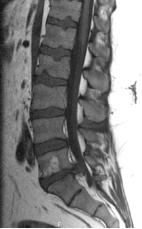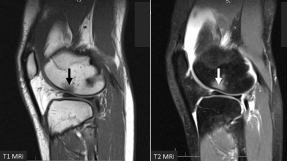Deck 5: Magnetic Resonance Imaging
Question
Question
Question
Question
Question
Question
Question
Question
Question
Question

Unlock Deck
Sign up to unlock the cards in this deck!
Unlock Deck
Unlock Deck
1/10
Play
Full screen (f)
Deck 5: Magnetic Resonance Imaging
1
On T1 MRI:
A) Fat appears dark gray
B) Inflammation is bright
C) Tendons appear light gray
D) Healthy tendons appear black
A) Fat appears dark gray
B) Inflammation is bright
C) Tendons appear light gray
D) Healthy tendons appear black
Healthy tendons appear black
2

-What type of imaging is displayed in this image?
A) T1 MRI
B) T2 MRI
C) STIR
D) MRI myelography
T1 MRI
3

-These are sagittal T1 (left) and T2 (right) MRIs of the knee of a gymnast who had a hard landing on extended knees. Based on imaging characteristics, what do the arrows indicate?
A) Fatty tumor
B) Bone marrow edema
C) A fracture line
D) Ossification
Bone marrow edema
4

-Compared with T1 MR images, T2 images:
A) Show greater resolution
B) Have higher signal from muscles
C) Have lower signal intensity from fat
D) Have lower signal intensity from water

Unlock Deck
Unlock for access to all 10 flashcards in this deck.
Unlock Deck
k this deck
5

-When selecting an MRI protocol for the highest anatomic detail, you would choose:
A) T2 MRI
B) STIR
C) T1 with gadolinium contrast
D) Proton density imaging

Unlock Deck
Unlock for access to all 10 flashcards in this deck.
Unlock Deck
k this deck
6

-This is an axial T2 image at the level of the femoral condyles. The open arrow points to the medial patellar retinaculum. What does the solid arrow point to?
A) Edema
B) Fatty tumor
C) Hemorrhage
D) Osteogenic tumor

Unlock Deck
Unlock for access to all 10 flashcards in this deck.
Unlock Deck
k this deck
7
Open and upright MRI scanners have the advantages of:
A) Higher field strengths and thus better resolution
B) Ability to perform movements while scanning
C) Shorter scanning times
D) Less chance of image degradation
A) Higher field strengths and thus better resolution
B) Ability to perform movements while scanning
C) Shorter scanning times
D) Less chance of image degradation

Unlock Deck
Unlock for access to all 10 flashcards in this deck.
Unlock Deck
k this deck
8
The advantages of MRI include:
A) No ionizing radiation
B) Fast imaging times
C) Optimal imaging of cortical bone
D) Relatively inexpensive
A) No ionizing radiation
B) Fast imaging times
C) Optimal imaging of cortical bone
D) Relatively inexpensive

Unlock Deck
Unlock for access to all 10 flashcards in this deck.
Unlock Deck
k this deck
9
MRI myelography:
A) Refers to the use of gadolinium contrast injected into the cerebrospinal fluid
B) Refers to the study of the spinal canal with high-resolution T2 MRI
C) Is done in conjunction with radiographic myelography
D) Is the use of enhanced proton density imaging
A) Refers to the use of gadolinium contrast injected into the cerebrospinal fluid
B) Refers to the study of the spinal canal with high-resolution T2 MRI
C) Is done in conjunction with radiographic myelography
D) Is the use of enhanced proton density imaging

Unlock Deck
Unlock for access to all 10 flashcards in this deck.
Unlock Deck
k this deck
10
The value of STIR images lies in their superior ability to detect:
A) Fractures
B) Bone marrow
C) Edema
D) Muscle detail
A) Fractures
B) Bone marrow
C) Edema
D) Muscle detail

Unlock Deck
Unlock for access to all 10 flashcards in this deck.
Unlock Deck
k this deck



